
views
Team Setup

Gather nine players. You will need at least nine people to be able to field a team for defense. It is possible to play with fewer people, but you'll need to expand each player's coverage on the field. This may make it difficult for players to reach the ball after it's hit though, so get as close to nine as possible.

Assign the pitcher and catcher. The pitcher is the player who stands in the middle of the field and throws the ball to the batter. The catcher will be squatting just behind the batter at home plate to catch the ball if the batter doesn't hit it. Make sure the catcher wears protective gear, like a face mask, since the pitcher will be throwing balls hard and fast enough to injure them.

Select the infielders. The players in the infield (or the diamond) protect the bases. There should be a player stationed at first, second, and third base, and they will be referred to as "basemen." Make a fourth player the shortstop, which is a roving position that backs up the the basemen and helps catch balls in the infield.

Choose the outfielders. The three players in the outfield are the right fielder, center fielder, and left fielder. They're responsible for catching fly balls in the outfield and chasing down ground balls that make it past the infield.
Field Setup

Place the bases on the field. There are four bases (first, second, third, and home plate), which are “safe spots” for runners during the game. They’re canvas or rubber-covered bags set up in a square, though it’s more commonly referred to as a diamond. Bases are numbered counterclockwise from home plate: first, second, and third. Second base is on a direct line from home plate through the pitcher's mound. Each base is approximately 90 feet (27.5 meters) away from the previous one. The lines that connect the bases are made of dirt, so that runners may slide into bases, while the rest of the field is made of grass.
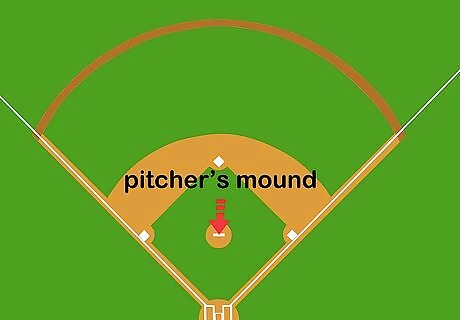
Set up the pitcher’s mound. The pitcher stands on a mound of dirt in the center on the diamond, approximately 60 feet (18 meters) from home plate. On the mound, place a small rubber plate, where the pitcher will throw from.

Paint the foul lines. A baseball that's hit and lands to the left of third base or the right of first base (as seen from home plate) is considered a “foul ball,” which invalidates the play. The foul lines extend from home plate out to the first and third bases, and then beyond into the outfield.

Paint the batter’s boxes. The batter stands either on the left side of home plate or the right side, depending on which is their dominant hand. Paint a 4-foot by 6-foot (1.2 meters by 1.8 meters) box on both sides of home plate.

Paint the catcher’s box. Just behind home plate, paint a small box where the catcher and umpire (an impartial judge) will squat or stand and watch the ball after the pitcher throws it.
Offensive Play
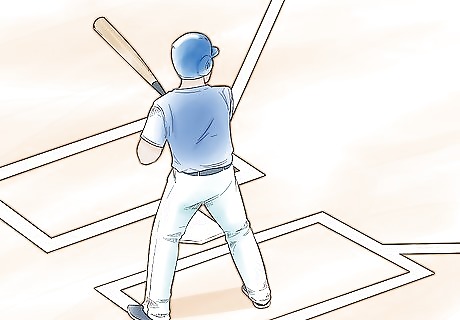
Send a batter to the plate. A batter will approach home plate and stand to the side of it in one of the batter’s boxes, waiting for the pitcher to throw the ball. Batters may take practice swings until the pitcher is ready to begin. During offensive play, all players act as batters, taking turns trying to hit the ball.

Watch the ball as it’s pitched. The batter must try to predict whether the ball will be hittable. They can decide whether to swing and attempt to hit the ball, or to not swing, and allow the catcher behind them to catch it. If a legal hit is not made, the umpire will make one of three calls – a strike, a ball, or a foul ball. A “strike” is an indication that the batter either could have swung at the ball and didn't, or swung at the ball and missed. The batter is out on a third strike that is caught by the catcher. A “ball” happens when the pitcher pitches a ball that's too far outside the hitting area to be considered hittable by the batter and the batter did not swing at the pitch. After four balls, the batter “walks,” which is a free advancement to first base. Batters will occasionally try to crowd the plate and earn a walk rather than hit the ball. A “foul ball” is a ball that the batter hits which lands outside the foul lines or goes into foul territory before reaching first or third base. The ball is then considered "dead," and all runners must return to their time-of-pitch base without any liability of being put out. Usually a foul ball just counts as a strike; however, in most cases, a foul does not count as a strike if there are already two strikes against the batter. Exceptions are if the batter foul-tips the ball into the catcher's glove or bunts it foul.

Swing the bat. While standing with your feet parallel and knees slightly bent, hold the bat upright at the base with two hands. Swiftly bring it forward in a fluid motion, and at the same time, shift your weight from your back foot to your front foot. Don’t forget to keep your eye on the ball to increase your chances of making contact.

Run the bases. While the hit ball is moving across the field, either through the air or along the ground, the batter (who is now called the “runner”) drops the bat and runs as fast as possible towards first base. As long as the runner doesn't get an “out,” they can stop at first base, or keep going until it's no longer safe. A runner can be tagged out if a defensive player has possession of the ball and touches the runner who is not touching a base (and has not overrun first base). The batter will automatically be called out if the hit ball is caught by a defensive player before it touches the ground or wall. This is called a flyout. If this is not the third out of the inning, all baserunners must return to their time-of-pitch-base after a flyout. Such runners can be "doubled off" by throwing the ball back to the base that must be reached. A batter can get forced out if the hit ball touches the ground, but then a defensive player gets possession of it and touches first base before the runner can get there. Runners who are "forced" to vacate their base on a ground ball can also be forced out in this manner.

Steal bases. In most instances, the runner won't be able to complete an entire circuit of the bases on a single play, so they must stop at a base and wait for the next batter to step up to the plate. However, at any time, the runner may attempt to “steal” the next base by running to it as soon as the pitcher has pitched to the batter. Since the pitcher is usually the best thrower on the team, stealing a base at any other time is very dangerous; the pitcher can turn and throw the ball to a baseman instead of the batter, allowing an easy tag out. Many youth baseball leagues do not permit base stealing until after the ball has crossed home plate.
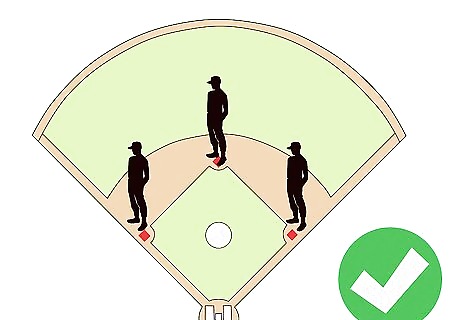
Load bases. Only one runner is allowed on each base at any time. When all three bases have a runner, the offensive team is said to have the “bases loaded,” meaning the next fair hit or walk will necessarily result in either a run or an out.

Hit a home run. Sometimes, the batter hits the ball so hard or so well that they are able to run around the entire diamond before getting an out, scoring a run on the first hit. This is called a “home run.” Most home runs are the result of the ball being hit past the fence at the back of the outfield, at which point it's completely out of play and all the fielding team can do is watch. A home run hit while the bases are loaded is called a “grand slam,” which will score four runs (one for each runner). While rare, grand slams can turn the tide of a difficult game or virtually guarantee victory.
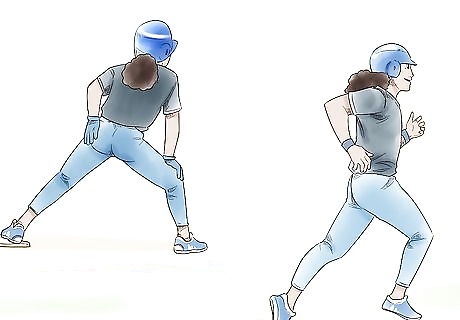
Drive forward with regular plays. Home runs are fun, but not common enough to be relied upon as a means of winning the game. Instead, focus on learning how far to run after a normal hit. By knowing when to stop and wait, you can stay in play longer and raise your chances of scoring a run.

Avoid getting three “outs.” Once three batters/runners have gotten outs, the game shifts, with the defense and offense switching places. While you’re the defense team, you will not be able to score any runs. The game has nine periods, called innings. They’re each comprised of two parts: a “top” and a “bottom.” When the offense of one team has received three outs, the game moves either to the bottom of the current inning or the top of the next one. A run scores for the offensive team whenever a runner safely advances to home plate. A run will not count if: 1) the runner at home plate was not at the time-of-pitch base during or after a flyout; 2) the runner touched home plate after the defensive team recorded a third out; or 3) the runner reached home plate during the same continuous playing action as a force out for the third out, even if home plate was reached before this out was recorded.
Defensive Play

Pitch the ball. The pitchers will stand on the pitcher’s mound and throw the ball toward the hitter, attempting to get an out. Pitchers often use fastballs, curveballs, changeups, and sliders to confound batters. The fastball is what it sounds like – very fast – as is the curveball. A changeup involves the pitcher pretending to throw a fastball but actually throwing a much slower pitch, confusing the batter's sense of timing.

Try to catch the ball after it’s hit. Once the batter hits the ball, it will either fly through the air or it will roll along the ground. The defensive team, which is spread out across the infield and the outfield (the grass beyond the diamond), will attempt to catch the ball before it hits the ground. This automatically gives the batter an out and they can’t proceed to run the bases. If the ball hits the ground before anyone catches it, the defensive players must get to it quickly and pass it to any teammate close enough to tag or force a runner out.

Try to tag runners out. As long as they have the ball in hand, a defensive player can tag a runner as they are circling the bases, and the runner will then be out. Or a baseman (the person in charge of guarding a base) can catch a passed ball and step one foot on the base in order to get an out for a forced runner who was approaching that base.

Get multiple runners out at once. When the field is set up just right, the fielders may be able to pull off a double play or even a triple play, in which they get two or three outs on a single play. Triple plays are rare but sometimes possible on line drive flyouts, or if enough force outs are available. Double plays are more common, and they often involve forcing out a runner at second base and then forcing out the batter before they reach first.
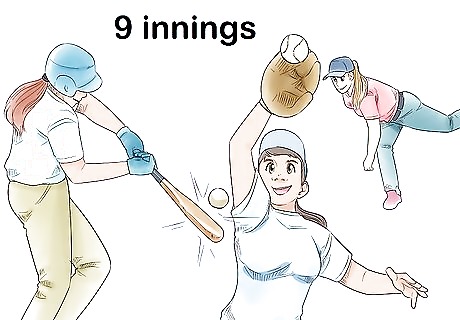
Keep playing until the correct number of innings is reached. As opposed to basketball and many other team sports, baseball doesn't have a clock or timer. Instead, the game is played until all the innings are completed. At the end of the last inning, whichever team scored the most runs wins. Because this can make games drag on for a long time, teams are allowed to have alternates, particularly extra pitchers (called relief pitchers) to keep play fresh from beginning to end. If the teams are tied at the end of the last inning, an extra inning is played. It is very unusual for a baseball game to end in a tie; typically, extra innings are added until one team manages to score. If the team that scored is an away team, then the home team gets to have one more chance to score. If the home team can't score, the away team wins.



















Comments
0 comment